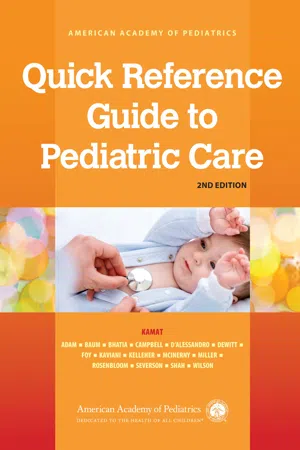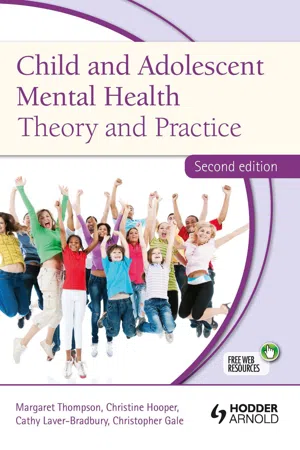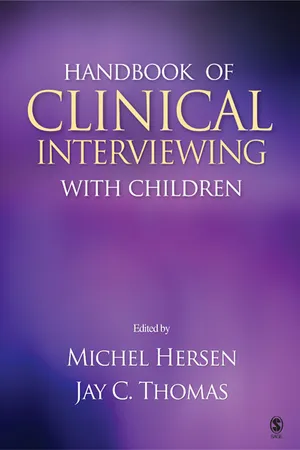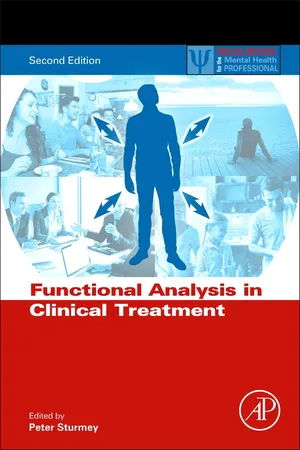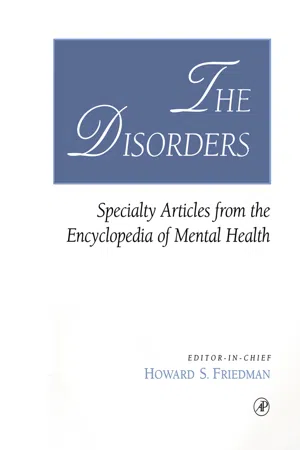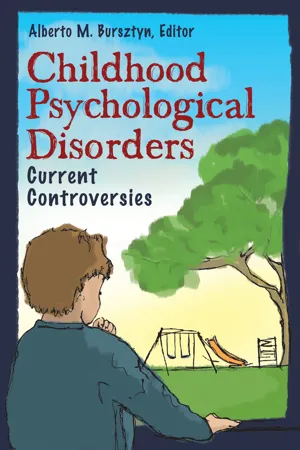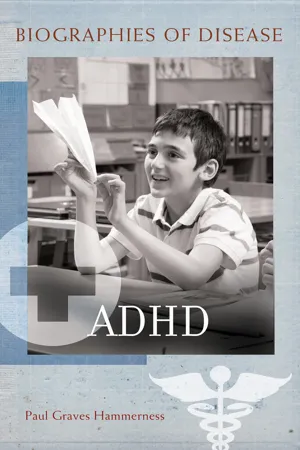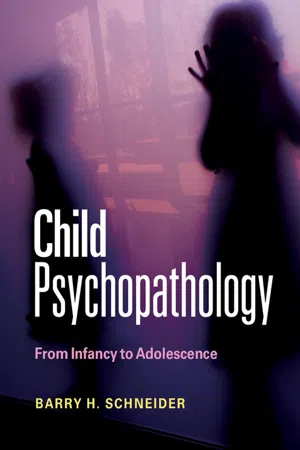Psychology
Attention Deficit Hyperactivity Disorder
Attention Deficit Hyperactivity Disorder (ADHD) is a neurodevelopmental disorder characterized by inattention, hyperactivity, and impulsivity. It often begins in childhood and can persist into adulthood. Symptoms can impact academic, occupational, and social functioning. Treatment typically involves a combination of medication, behavioral therapy, and support strategies tailored to the individual's needs.
Written by Perlego with AI-assistance
Related key terms
1 of 5
12 Key excerpts on "Attention Deficit Hyperactivity Disorder"
- eBook - PDF
- Deepak M. Kamat(Author)
- 2017(Publication Date)
- American Academy of Pediatrics(Publisher)
80 A Attention-Deficit/Hyperactivity Disorder DEFINITION ■ ■ Attention-deficit/hyperactivity disorder (ADHD) is a common neurodevelopmental disorder in children and adolescents. ■ ■ Frequently diagnosed in children with academic underachievement or behavioral problems. ■ ■ Hallmarks are hyperactivity, impulsivity, and inattention that are beyond normal developmental expectations for a child’s age. ■ ■ Core symptoms interfere with attainment of many normal developmental milestones (academic, fine motor, and social and adaptive skills). SIGNS AND SYMPTOMS Diagnostic and Statistical Manual of Mental Disorders, 5th Edition ( DSM-5 ) Criteria for Diagnosis (Box 1) ■ ■ Combined presentation: If both Criterion A1 (inattention) and Criterion A2 (hyperactivity-impulsivity) are met for the past 6 months. ■ ■ Predominantly inattentive presentation: If Criterion A1 (inattention) is met but Criterion A2 (hyperactivity-impulsivity) is not met for the past 6 months. ■ ■ Predominantly hyperactive-impulsive presentation: If Criterion A2 (hyperactivity-impulsivity) is met and Criterion A1 (inattention) is not met for the past 6 months. ■ ■ Because symptoms can change over time, the presentation may change over time as well. ■ ■ The DSM-5 criteria do not account for differences in presentation by age, sex, or race/ethnicity; clinicians must exercise judgment in their use of the criteria. ■ ■ Any symptoms suggestive of possible harm to self or others warrant immediate evaluation by a skilled clinician. - eBook - PDF
Child and Adolescent Mental Health
Theory and Practice, Second Edition
- Christine Hooper, Margaret Thompson, Catherine Laver-Bradbury, Chris Gale, Christine Hooper(Authors)
- 2012(Publication Date)
- CRC Press(Publisher)
Attention Deficit Hyperactivity Disorder (ADHD) is a syndrome characterized by severe inattention, hyperactivity and impulsivity to a degree that is maladaptive or inconsistent with the developmental level of the child. To meet the DSM-IV criteria for diagnosis, symptoms should be pervasive across situations, persistent in time and start before the age of seven years (American Psychiatric Association, 2000). ADHD is present in approximately 6 per cent of the population (Schachar, 1991). Some British clinics tend to use the stricter International Classification of Disease version 10 (World Health Organization, 1993) criteria for Hyperkinetic Disorder, which demands that onset be before the age of seven years, with a set number of symptoms of inattention, overactivity and impulsivity. ADHD affects around 6 per cent of the population (Barkley, 2006). Hyperkinetic disorder affects approximately 1 per cent of children at primary school age, with a male to female ratio of around 3:1 (Taylor et al., 1991). Children with ADHD have an increased likelihood of having other medical, developmental, behavioural, emotional, social (with a financial impact on services due to educational and society breakdown) and academic difficulties (Mannuzza et al., 1998), and the disorder often severely affects family life (Barkley et al., 1990). These children can be very aggressive. Forty per cent of children with ADHD will continue to have problems in adulthood. Some may require referral to adult psychiatrists (Faraone et al., 2006). Aetiology: current thinking The brains of these children are different. Multiple studies of groups of children with ADHD compared to control groups have documented anatomical differences, for example reductions of about 10 per cent in size of the caudate nucleus, right frontal and cerebellar vermis regions of the brain. - Michel Hersen, Jay C. Thomas(Authors)
- 2007(Publication Date)
- SAGE Publications, Inc(Publisher)
16 A TTENTION -D EFICIT / H YPERACTIVITY D ISORDER B RAD C. D ONOHUE , R ACHEL E. S IMMONS , AND S TEPHANIE A. D EVORE D ESCRIPTION OF THE D ISORDER Attention-deficit/hyperactivity disorder (ADHD) is a frequently diagnosed childhood behavi-oral condition that has a particularly negative influence on learning disabilities and conduct disorders (Quinn, 1997). In this disorder, abnor-malities in the executive functions of the pre-frontal cortex and limbic systems of the frontal lobes as well as the reticular activating system are found in affected youth (Barkley, Grodzinsky, & DuPaul, 1992; National Institutes of Health [NIH], 2000; Quinn, 1997), resulting in deficits in attention, activity level, and impulsivity (Barnett & Labellarte, 2002). Monozygotic and dizygotic twin studies suggest ADHD is genetically trans-mitted (Cantwell, 1972; Morrison & Stewart, 1971, 1973). As in many psychological disorders, it is not currently known whether the presence of ADHD symptoms represents the presence of a discrete disease or a continuum of characteristics. Nevertheless, the utility of diagnosis and treat-ment are evident in ameliorating the disorder’s effects (NIH, 2000). Diagnostic Criteria The American Psychiatric Association’s Diagnostic and Statistical Manual of Mental Disorders, Fourth Edition, Text Revision (DSM-IV-TR) (APA, 2000) outlines the diagnostic cri-teria for three subtypes of ADHD: primarily inattentive (ADHD-I), primarily hyperactive (ADHD-H), and combined (ADHD-C). Symp-toms for diagnosis of any of the subtypes (see below) must be present prior to age 7 and per-sist for a minimum of 6 months at a level that is maladaptive and inconsistent with the child’s developmental level. In addition, symptoms must be present in two or more settings and cause significant impairment in social, acade-mic, or occupational functioning.- eBook - PDF
- Peter Sturmey(Author)
- 2020(Publication Date)
- Academic Press(Publisher)
Chapter 5 Attention Deficit Hyperactivity Disorder Nancy A. Neef a , Christopher J. Perrin b , John Northup c , y a Educational Studies, The Ohio State University, Columbus, OH, United States; b Psychology & Counseling, Georgian Court University, Lakewood, NJ, United States; c University of Iowa, Department of Psychological and Quantitative Foundations, Iowa City, IA, United States Diagnosis and related characteristics Attention Deficit Hyperactivity Disorder (ADHD) is a disorder of unknown etiology with defining characteristics of inattention, overactivity, and impul-sivity ( American Psychiatric Association [APA], 2013 ). It is the most preva-lent disorder in the school-age population of children in the United States, and has been continuously increasing. Although the DSM-V estimates that ADHD affects 5% of children, recent population studies have yielded much higher estimates (e.g., 9.4% of children age 2 e 17 years according to Danielson et al., 2018 ; 10.2% of children age 4 e 17 years according to Xu, Strathearn, Liu, Yang, & Bao, 2018 ). ADHD is much more common in males than in females; the ratio is approximately 2:1, or 12.9% e 5.6% of males to females ( Danielson et al., 2018 ). ADHD is chronic. The results of prospective, longitudinal investigations indicate that, although the clinical presentation of ADHD evolves over the lifespan, symptoms (particularly inattention) persist into adulthood for approximately two-thirds of diagnosed children ( Biederman, Mick, & Far-aone, 2000; Cherkasova, Ponde, & Hechtman, 2012; Cherkasova, Sulla, Dalena, Ponde ´, & Hechtman, 2013; Faraone, Biederman, & Mick, 2006; Molina et al., 2009 ). ADHD frequently co-occurs with additional emotional, behavioral, and learning problems. For instance, Larson, Russ, Kahn, and Halfon (2011) found that 67% of children ages 6 to 17 with ADHD had at least one coexisting condition. - eBook - PDF
The Disorders
Specialty Articles from the Encyclopedia of Mental Health
- Howard S. Friedman(Author)
- 2001(Publication Date)
- Academic Press(Publisher)
Attention Deficit/ Hyperactivity Disorder(ADHD) Russell A. Barkleyand Gwenyth H. Edwards University of Massachusetts Medical Center I. Introduction II. Historical Context III. Description and Diagnosis IV. Theoretical Framework V. Potential Etiologies VI. Epidemiology of ADHD VII. Developmental Course and Adult Outcome VIII. Diagnostic Criteria IX. Conclusion Attention A multidimensional construct that can refer to alertness, arousal, selectivity, sustained atten- tion, distractibility, or span of apprehension. Contingency-Shaped Attention Continued re- sponding in a situation or to a task as a function of the immediate consequences provided by the task or activity. Developmental Disorder Any condition arising in childhood thought to be intrinsic to the individual that is characterized by functioning that is substan- tially below that expected, given the person's chrono- logical age. Goal-Directed Persistence The maintenance of responding that is controlled by the capacity to hold events, goals, and plans in mind and to adhere to those plans and other rules governing behavior. Hyperactivity Characterized by increased or ex- cessive movement of the body and its extremities. May be manifested as constant restlessness, fidgeti- ness, motor overactivity, or excessive talkativeness. 83 Impulsivity Reduced ability to resist an impulse or temptation to perform some action. Impulsive actions are those that are directed at obtaining immediate gratification without regard for the delayed conse- quences of the behavior. Reinforcement The consequences of behavior that increase the probability that the behavior will occur again. - eBook - PDF
Biological Child Psychiatry
Recent Trends and Developments
- T. Banaschewski, L. A. Rohde, W. P. Kaschka, W. F. Gattaz(Authors)
- 2008(Publication Date)
- S. Karger(Publisher)
Banaschewski T, Rohde LA (eds): Biological Child Psychiatry. Recent Trends and Developments. Adv Biol Psychiatry. Basel, Karger, 2008, vol 24, pp 1–20 Attention-Deficit/Hyperactivity Disorder David Coghill a Luis Augusto Rohde b Tobias Banaschewski c a University of Dundee, Section of Psychiatry, Division of Pathology and Neuroscience, Ninewells Hospital and Medical School, Dundee, UK; b ADHD Outpatient Program, Child and Adolescent Psychiatric Division, Hospital de Clinicas de Porto Alegre, Federal University of Rio Grande do Sul, Porto Alegre, Brazil; c Department of Child and Adolescent Psychiatry and Psychotherapy, Central Institute of Mental Health, Mannheim, Germany Abstract Objectives: To describe the main aspects of attention-deficit/hyperactivity disorder (ADHD), including the epidemiology, etiology, neurobiology, clinical features, comorbidities, diagnosis, outcome and treat-ment. Sources of Data: We performed a comprehensive, selective (nonsystematic) review of the litera-ture on ADHD. Summary of the Findings: ADHD is highly prevalent in children and adolescents, has a clear neurobiological basis and an easily detectable set of cohesive symptoms, is associated with impair-ments in different areas of functioning, and treatment is very efficacious, including the use of medication in most the cases. Copyright © 2008 S. Karger AG, Basel Attention-deficit/hyperactivity disorder (ADHD) is one of the most common mental disorders affecting children and adolescents. The core ADHD symptoms are perva-sive and impairing inattention, hyperactivity, and/or impulsivity. Due to its signifi-cant prevalence during the lifespan and associated impairments, the disorder is considered a major health problem [1]. This chapter addresses recent research findings on different aspects of ADHD that might translate into relevant clinical issues. Thus, an extensive review of the abundant literature on ADHD is beyond the scope of this chapter. - eBook - PDF
Childhood Psychological Disorders
Current Controversies
- Alberto M. Bursztyn Ph.D.(Author)
- 2011(Publication Date)
- Praeger(Publisher)
The longer this negative interaction persists, the more likely that the child will grow up frustrated and angry. In ADHD, like in few other childhood disorders, symptom expression and intensity varies; often as a consequence of the nature of the immediate 56 Childhood Psychological Disorders environment. Generally only children with significant impairments are diagnosed, and symptoms overlap with other disorders. If children do not receive adequate interventions to address ADHD symptoms, they are more vulnerable to other emotional and behavior difficulties that are a di- rect consequence of being misunderstood. Symptoms of ADHD that often go unaddressed may include difficul- ties with attention, planning, organization, executive function, and ten- dencies to display impulsivity and hyperactivity. Linked to the disorder are neurological difficulties in auditory-verbal processing, visual-spatial processing, sensory modulation, and motor planning, all of which can im- pact attention. Many children with ADHD are sensory underresponsive, meaning that it is harder for them to differentiate amongst stimuli in the environment. Richard Barkley, a well-regarded expert in this disorder, de- scribes ADHD as being constituted by two components: (a) hyperactivity, a problem with behavioral inhibition, and (b) attention problems, that is, deficits in executive function, primarily with a specific type of memory called working memory. Executive functioning involves memory, decision- making, organization, regulating alertness, sustaining effort, managing frustration, modulating emotion, and self-regulation and attention. Incon- sistent attention and the aforementioned symptoms are not conducive to success in a regular classroom. Children with ADHD often experience fail- ure in school and little positive feelings about the self. ADHD has been de- scribed as primarily a disorder that aversely affects school life, but it also poses significant problems at home and in the community. - ADHD is a collection of specific symptoms (e.g., inattention, distractibility, impulsivity, hyperactivity) beginning early in a person’s life that are unusual as compared with peers and that typically occur wherever the individual is (e.g., home, school) and cause significant problems. Historically, ADHD has been considered to be a disorder of childhood. However, it has become quite clear that many children do not ‘‘grow out of it,’’ and ADHD can continue to cause tremendous problems for an individual well into adulthood. For the purposes of this book, and acknowledging that the bulk of the litera- ture on ADHD deals with children, I will primarily refer to young persons with ADHD as a ‘‘child’’ with ADHD. This reference to ‘‘child’’ will encompass all pe- diatric age groups, through adolescence, unless there are special topics that would apply only to adolescents (such as driving) or adults. In addition, I will refer to ADHD as a ‘‘psychiatric disorder,’’ which is consistent with the American Psy- chiatric Association’s language for categorizing emotional, behavioral, and cogni- tive problems. I will use the pronoun ‘‘we’’ to refer to the community of doctors and researchers of which I am part. However, the information gathered here is based upon my personal, current understanding of ADHD, upon the literature, and upon my clinical experience working with children, adults, and families and is not intended to represent the views of all others involved in this field. Finally, given my training as a physician, and my clinical work as a child and adolescent psychiatrist, the approach to and discussion of ADHD is pri- marily from a medical viewpoint. Although the emphasis is on the serious problems that can occur with ADHD, this is not to suggest that the diagnosis of ADHD for all children and adults will universally yield bad outcomes.
- No longer available |Learn more
- (Author)
- 2014(Publication Date)
- College Publishing House(Publisher)
________________________ WORLD TECHNOLOGIES ________________________ Chapter 12 Attention Deficit Hyperactivity Disorder Attention-deficit/hyperactivity disorder A child not paying attention in class. ICD-10 F90. ICD-9 314.00, 314.01 OMIM 143465 DiseasesDB 6158 MedlinePlus 001551 eMedicine med/3103 ped/177 MeSH D001289 Attention Deficit Hyperactivity Disorder ( ADHD or AD/HD or ADD ) is a neuro-behavioral developmental disorder. It is primarily characterized by the co-existence of attentional problems and hyperactivity, with each behavior occurring infrequently alone and symptoms starting before seven years of age. ADHD is the most commonly studied and diagnosed psychiatric disorder in children, affecting about 3 to 5 percent of children globally and diagnosed in about 2 to 16 percent of school aged children. It is a chronic disorder with 30 to 50 percent of those individuals diagnosed in childhood continuing to have symptoms into adulthood. Adolescents and adults with ADHD tend to develop coping mechanisms to compensate for some or all of their impairments. It is estimated that 4.7 percent of American adults live with ADHD. ADHD is diagnosed two to four times more frequently in boys than in girls, though studies suggest this discrepancy may be partially due to subjective bias of referring ________________________ WORLD TECHNOLOGIES ________________________ teachers. ADHD management usually involves some combination of medications, behavior modifications, lifestyle changes, and counseling. Its symptoms can be difficult to differentiate from other disorders, increasing the likelihood that the diagnosis of ADHD will be missed. Additionally, most clinicians have not received formal training in the assessment and treatment of ADHD, particularly in adult patients. ADHD and its diagnosis and treatment have been considered controversial since the 1970s. The controversies have involved clinicians, teachers, policymakers, parents and the media. - eBook - PDF
Child Psychopathology
From Infancy to Adolescence
- Barry H. Schneider(Author)
- 2014(Publication Date)
- Cambridge University Press(Publisher)
More important, though, is the challenge of linking treatment more directly to the brain dysfunctions that may be discovered. Perhaps the new technology will enable direct examination of the workings of interventions, including, but not necessarily limited to, pharmacological interventions. The current awareness of the possible biases of research on the treatment of ADHD will hopefully lead to a clearer picture of the effects of the various interventions, less fettered by disciplinary allegiance and commercial interests. As part of that process, the appropriate coordination of pharmacological and psychosocial therapies will hopefully emerge. Attention deficit/hyperactivity disorder 322 Environmental and dietary factors cannot be ruled out as explanations for the increase. • ADHD can continue throughout an individual’s life, although the symptoms often shift from those of hyperactivity to those of inattention. • The majority of children diagnosed with ADHD are male. Many point to demands placed by schools on boys that are inconsistent with their natural temperaments. • Research on girls with ADHD has revealed that, compared to their male counterparts, they are more likely to experience comorbid depression and anxiety, whereas boys often experience comorbid aggression. ADHD in girls has also been related to eating disorders, substance use disorders and anti-social behavior later in life. • There is some discrepancy in the prevalence of ADHD among various countries. However, when rigorous, standardized testing is done, these differences are often minimal. • Childhood ADHD often persists into adolescence, and, to some extent, into adulthood. • Individuals with ADHD are more likely than others to discontinue their schooling at an earlier age, to demonstrate poor school results and to repeat school years. They have fewer friends and lower reported self-esteem, and often have comorbid anxiety disorders, mood disorders and substance use disorders. - eBook - PDF
- Eric Mash, Eric Mash, David Wolfe, Katherine Nguyen Williams(Authors)
- 2023(Publication Date)
- Cengage Learning EMEA(Publisher)
This gives rise to inconsistent findings and presents concerns with interpretation and generalization. Second, ADHD includes a complex set of symptoms, making the search for a single neurobiological cause too simplis- tic. Third, the differences in brain structure, connec- tivity, and activity seen in ADHD (and other disor- ders) are usually meaningful only when comparing group statistics. The amount of variation in brain structure, connectivity, or function from one brain to the next is simply too great to be diagnostic or predictive for an individual, given what we currently know (Insel, 2010). Although research using brain imaging has greatly advanced our understanding of ADHD, more is needed before neuroimaging pro- cedures and findings can be integrated into clinical practice (Bush, 2008). Neurophysiological and Neurochemical Findings Precise neurophysiological and neurochemical differences underlying ADHD have been extremely difficult to docu- ment (Scassellati et al., 2012). No consistent differences Children with ADHD participating in a Summer Treatment Program. Copyright 2024 Cengage Learning. All Rights Reserved. May not be copied, scanned, or duplicated, in whole or in part. Due to electronic rights, some third party content may be suppressed from the eBook and/or eChapter(s). Editorial review has deemed that any suppressed content does not materially affect the overall learning experience. Cengage Learning reserves the right to remove additional content at any time if subsequent rights restrictions require it. 297 Chapter 8 Attention-Deficit/Hyperactivity Disorder (ADHD) were encouraged to withhold foods containing artificial flavorings, colorings, preservatives, and sugars. Such beliefs were debunked by the 1990s (McGee, Stanton, & Sears, 1993). - eBook - PDF
Stahl's Self-Assessment Examination in Psychiatry
Multiple Choice Questions for Clinicians
- Stephen M. Stahl(Author)
- 2019(Publication Date)
- Cambridge University Press(Publisher)
Attention Deficit Hyperactivity Disorder (ADHD) and its Treatment 289 QUESTION ONE Peter, a 35-year-old stockbroker, has been advised by his supervi- sor to come and see you, the company mental health consultant. His supervisor is complaining that he often comes late to appoint- ments, is inappropriately fidgety, interrupts people during meetings, has been offensive towards coworkers, and has been known to party excessively on weeknights. Peter asserts that he is just fine; he has a lot of projects on his mind and is simply standing up for himself when speaking with others. He likes to go out in the evenings to unwind. Recognizing probable ADHD, you interview both the patient and his work buddy, who is a long-time friend. How would you start your questions? A. Compared to his parents, how often does the patient … B. Compared to other people his age, how often does the patient … C. Compared to his childhood, how often does the patient … D. Compared to his children, how often does the patient … 8 Attention Deficit Hyperactivity Disorder (ADHD) AND ITS TREATMENT STAHL’ S SELF- ASSESSMENT EXAMINATION IN PSYCHIATRY Attention Deficit Hyperactivity Disorder (ADHD) and its Treatment 290 Answer to Question One The correct answer is B. Choice Peer answers Compared to his parents, how often does the patient … 1% Compared to other people his age, how often does the patient … 83% Compared to his childhood, how often does the patient … 16% Compared to his children, how often does the patient … 0% The symptoms of ADHD can present differently in patients at dif- ferent ages. While hyperactivity is a main symptom in children, for example, this will frequently translate into internal restlessness in adults. A and D – Incorrect. While ADHD has a strong genetic component, it is not advised to ask him first to compare himself to either his children or his parents. An accurate family history would be beneficial, however.
Index pages curate the most relevant extracts from our library of academic textbooks. They’ve been created using an in-house natural language model (NLM), each adding context and meaning to key research topics.
